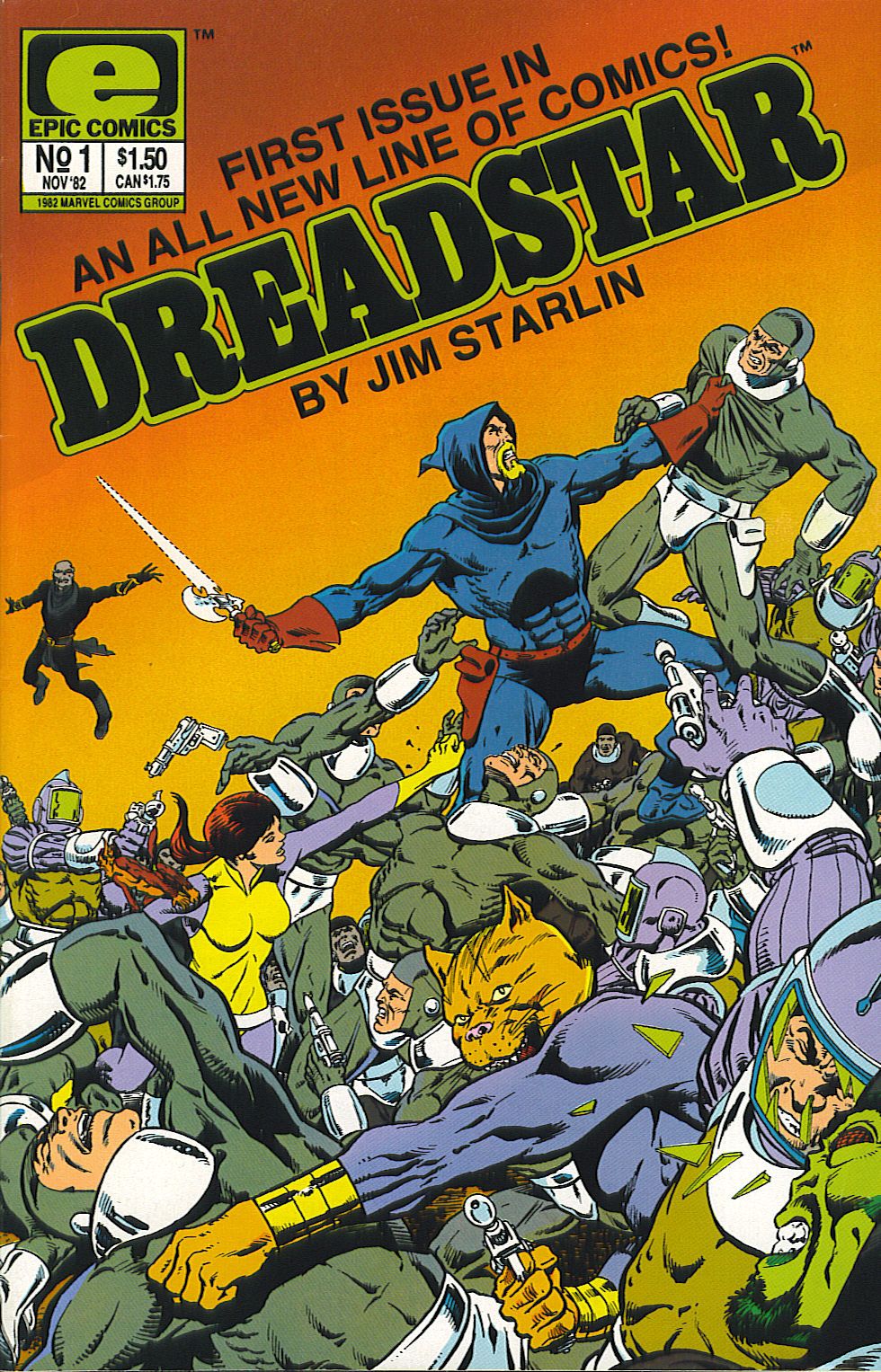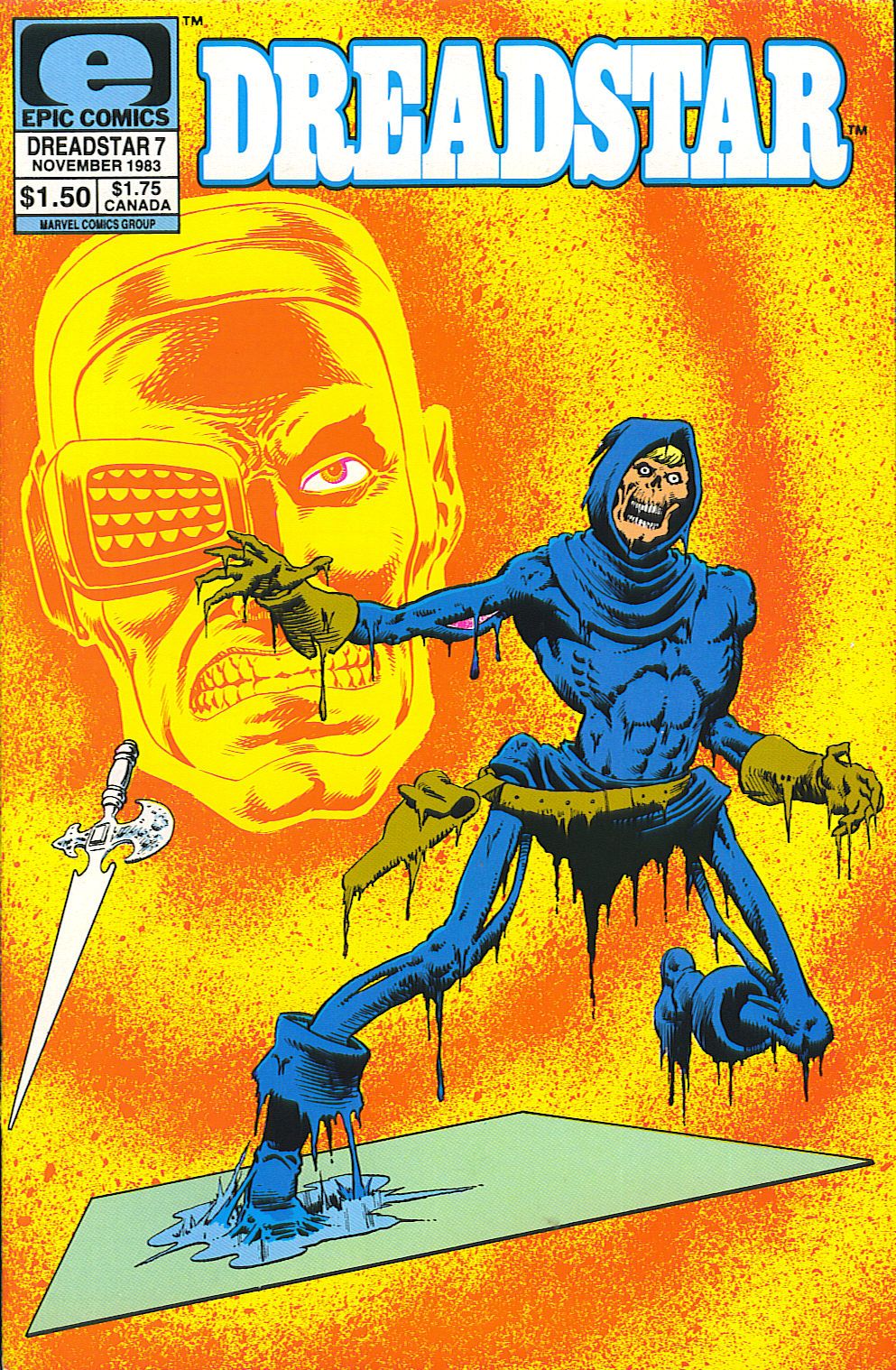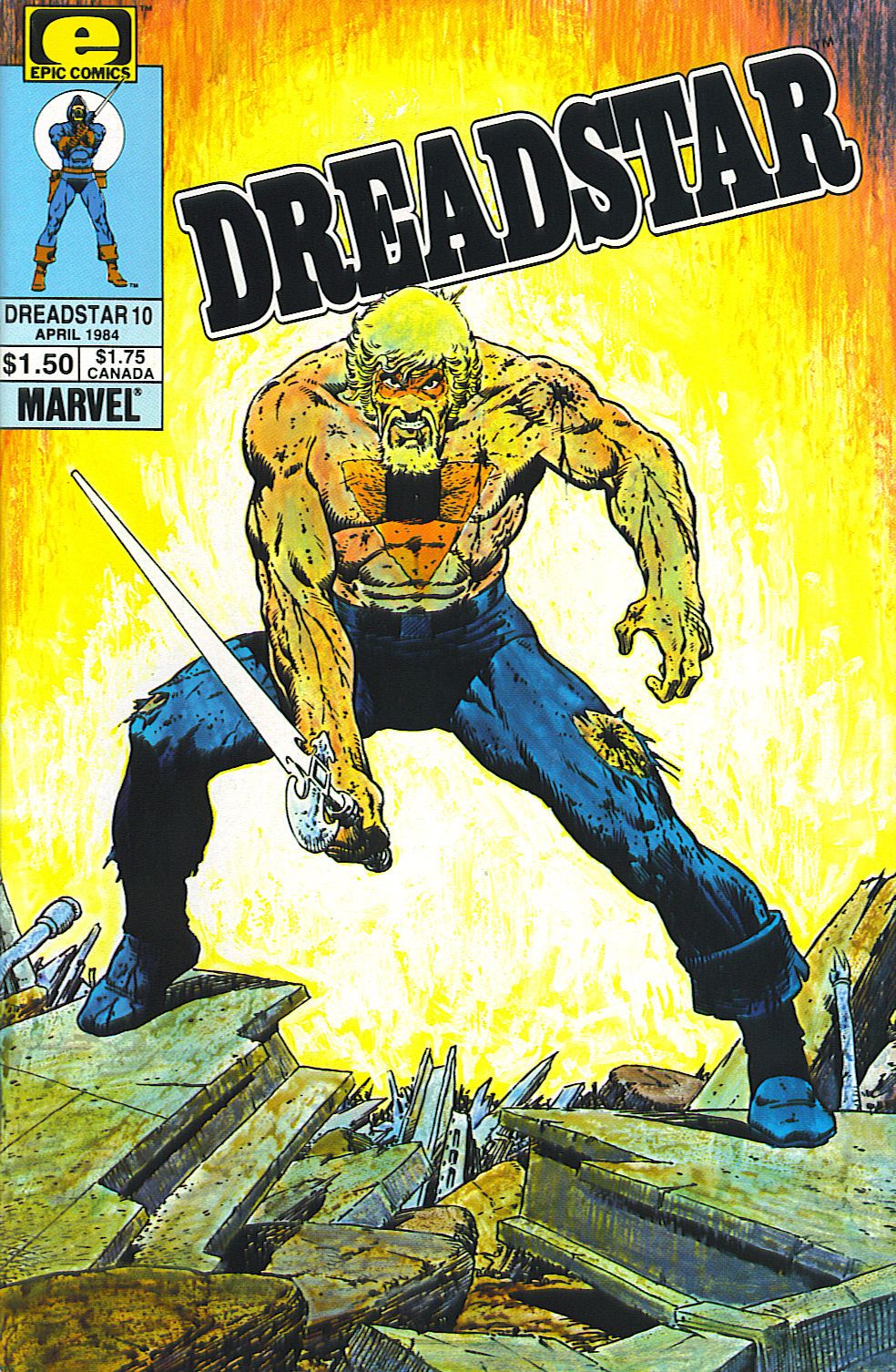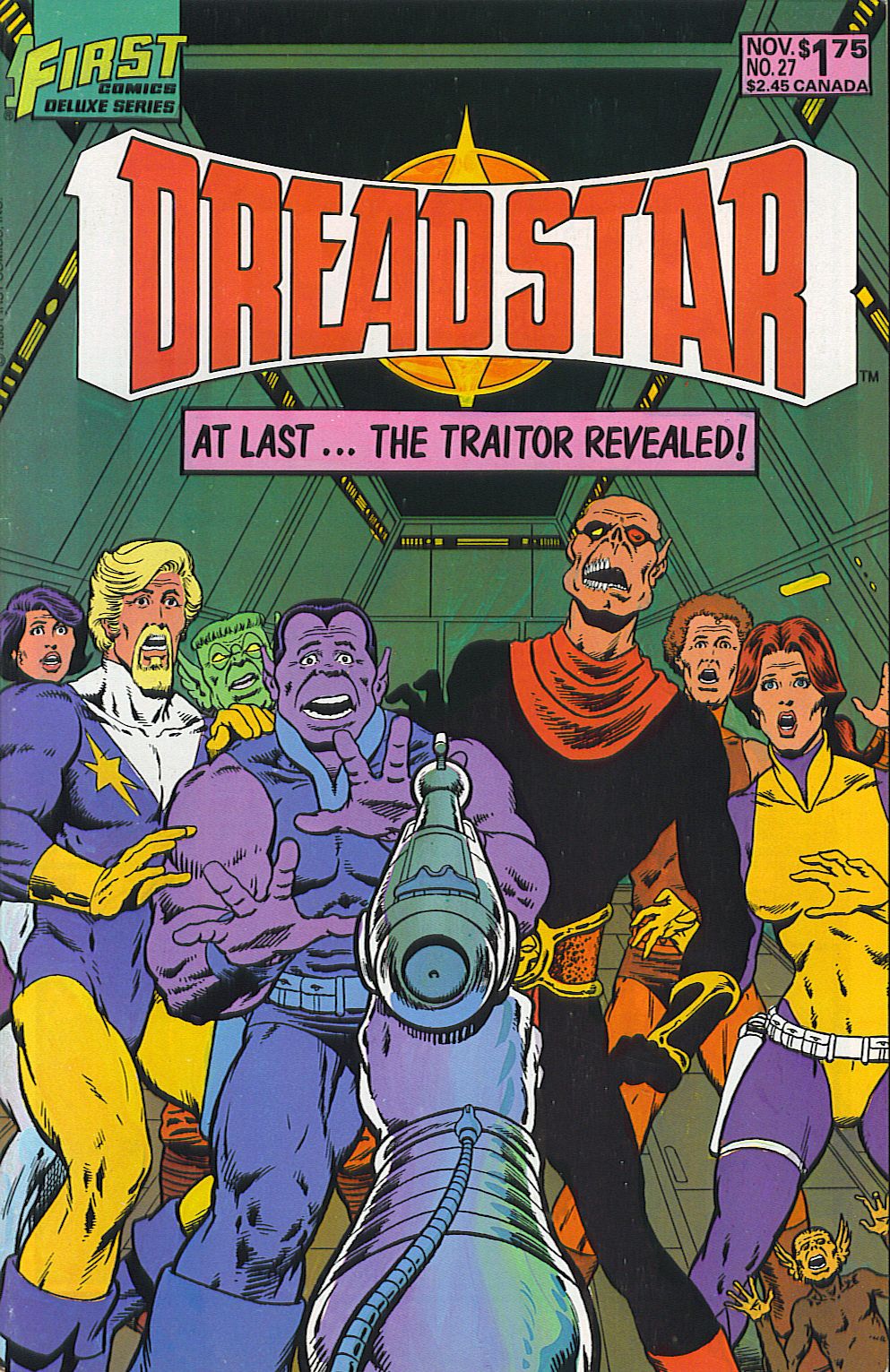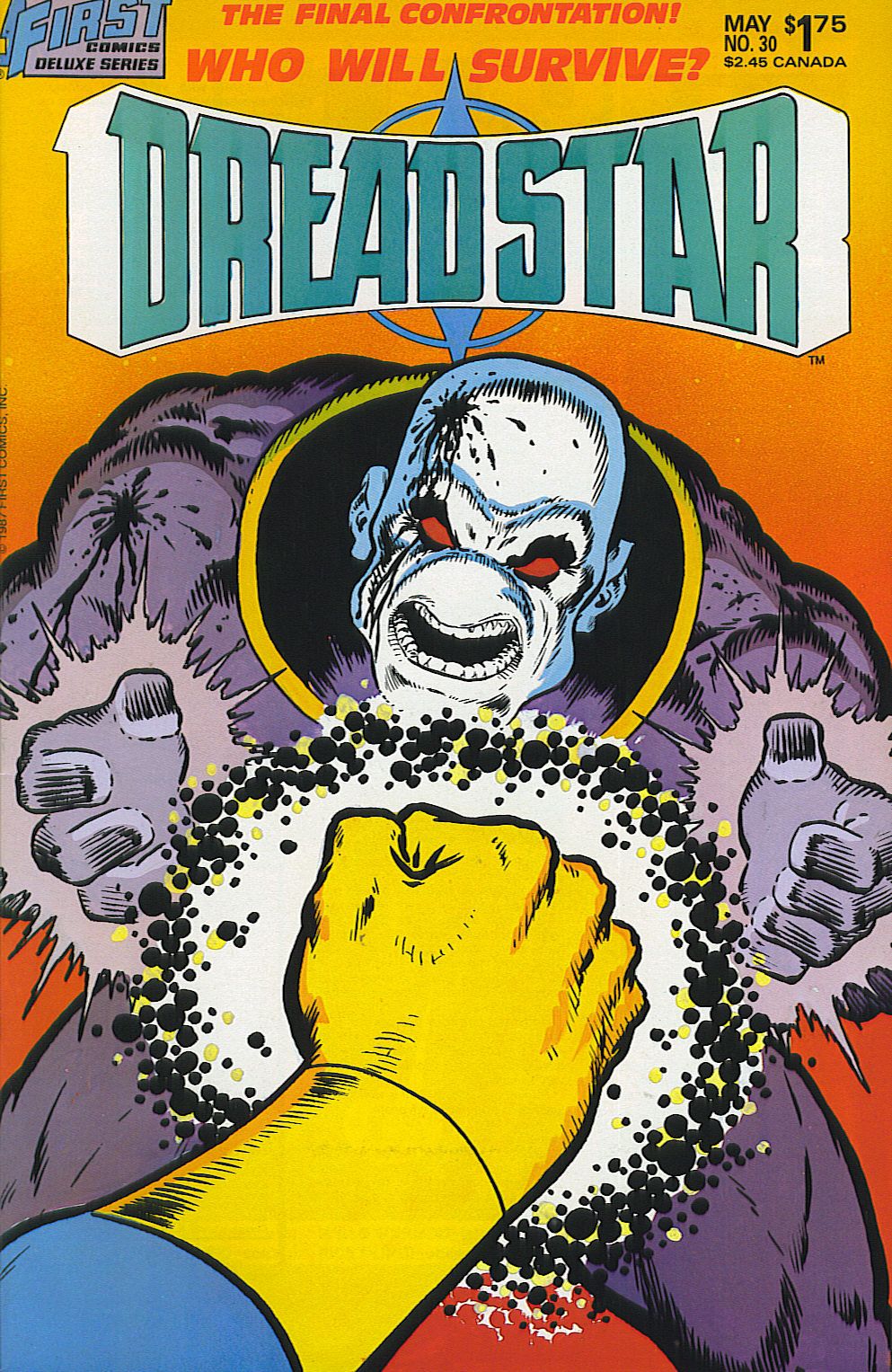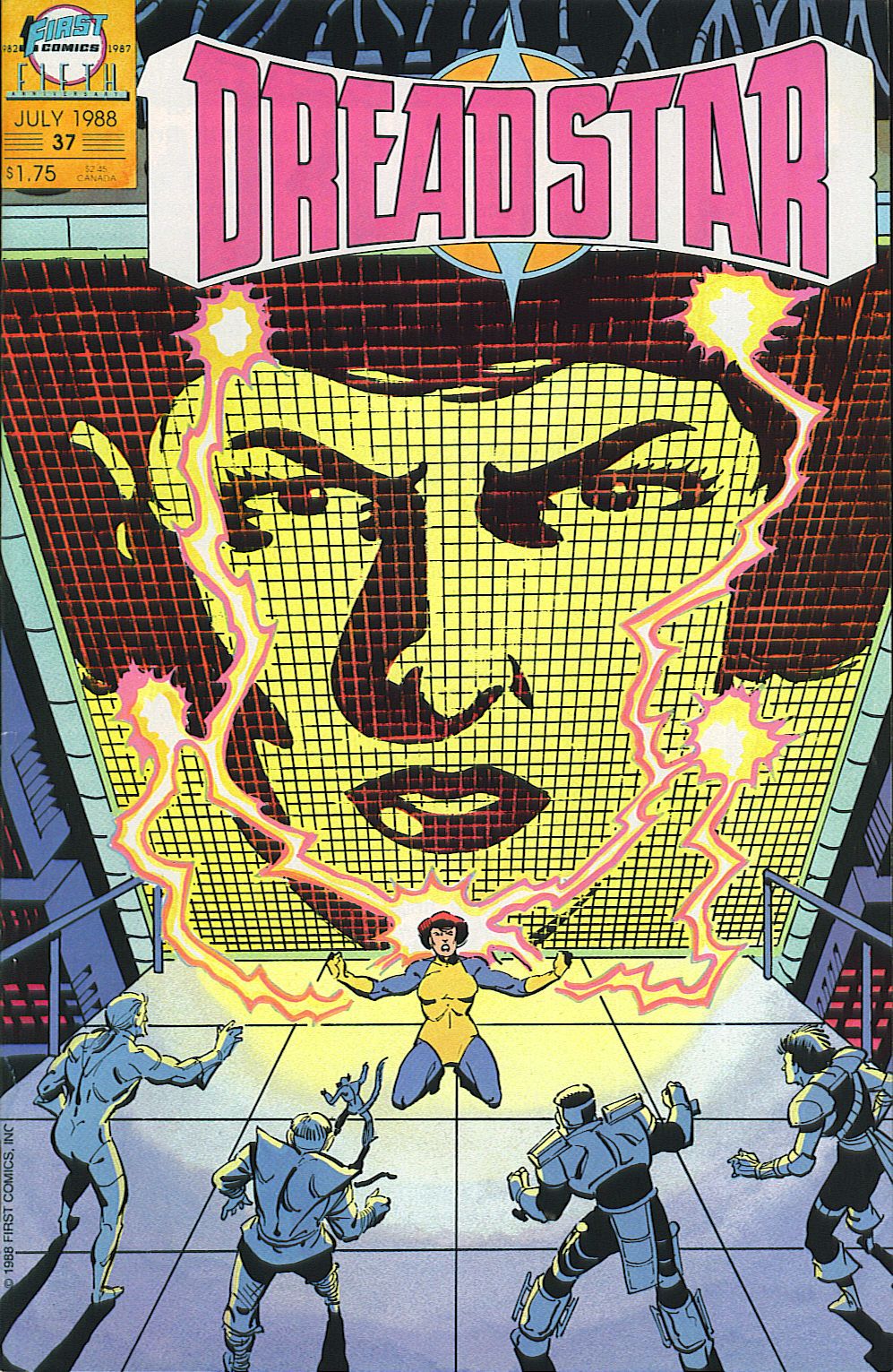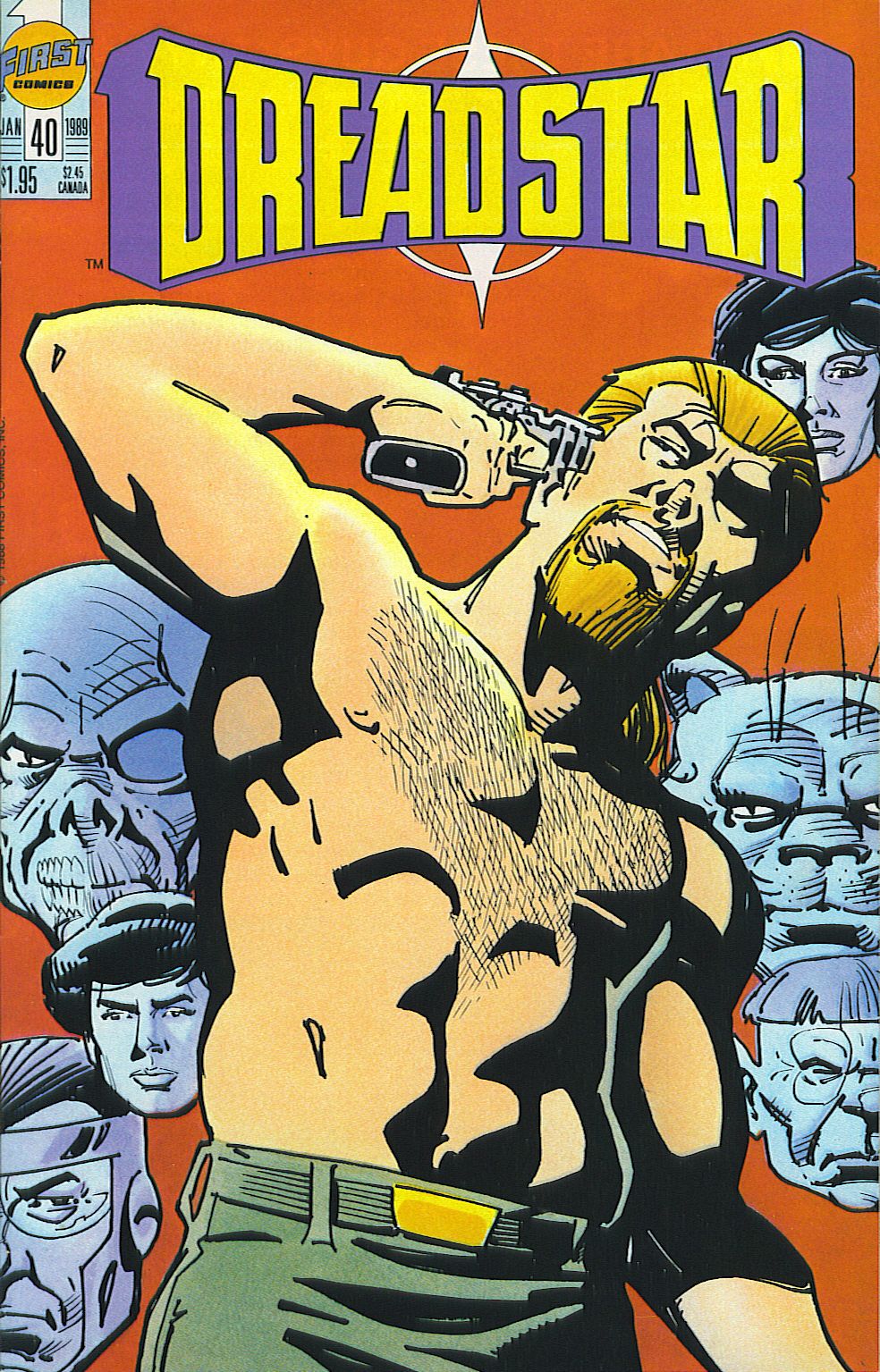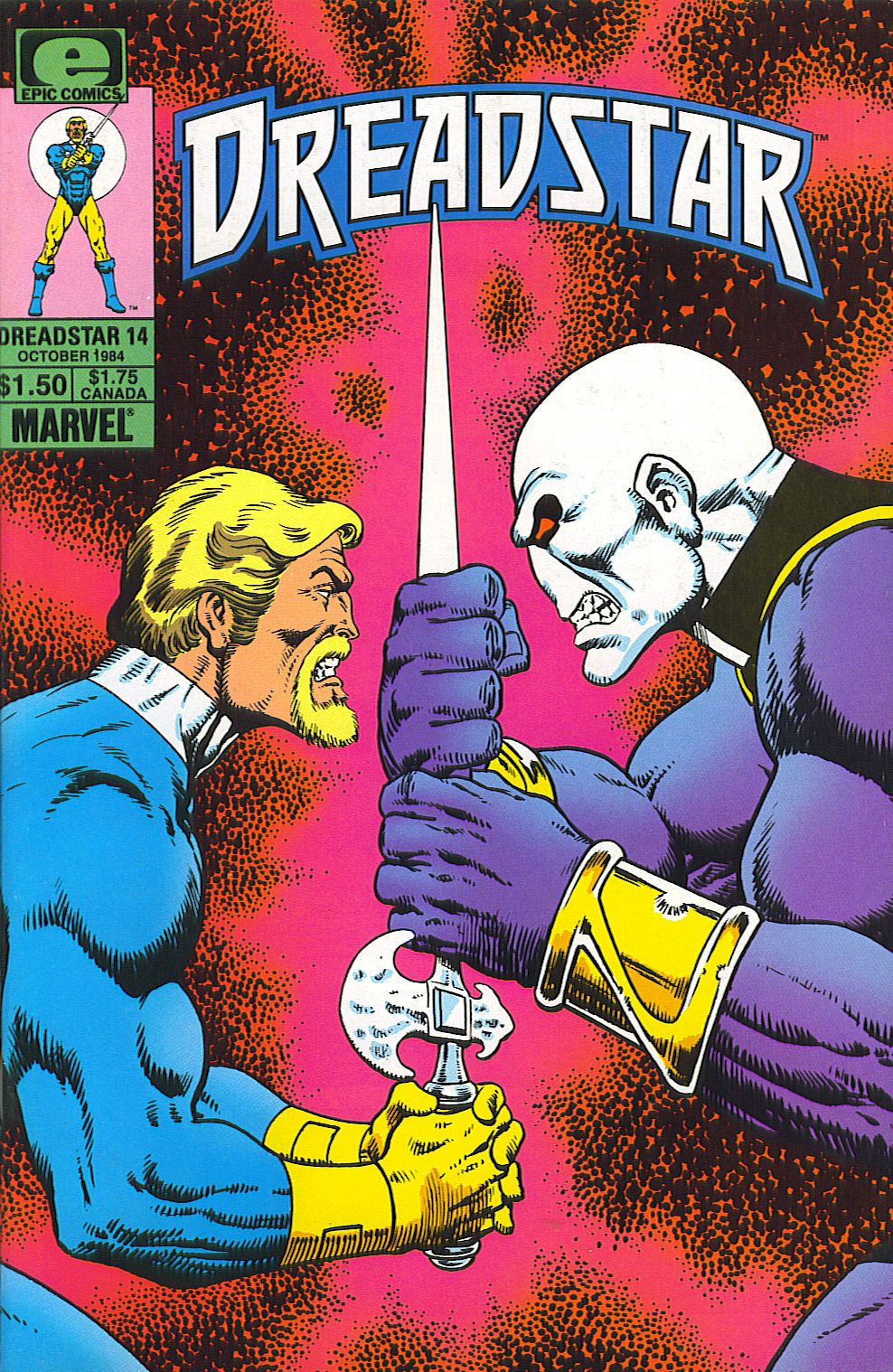Next up on the list of Comics You Should Own is a little tale of a space-faring rebel with his band of troublemakers. I didn't write about Dreadstar after Doom Patrol to prove not all Comics You Should Own are deep, philosophical stories about the very nature of existence and the desire for love, but can sometimes be grand space operas, it just worked out that way in the alphabetical set up. So let's get to it - Jim Starlin's epic! (As usual, plenty of SPOILERS lurk below! You've been warned!)
Dreadstar by Jim Starlin (writer; artist, issues #1-23, 25-32), Jim Sherman (artist, issue #24), Luke McDonnell (penciller, issue #33-38, 40), Angel Medina (penciller, issue #39), Al Milgrom (inker, issue #5), Josef Rubinstein (inker, issue #6-7), Kim DeMulder (inker, issue #8), Sam De La Rosa (inker, issue #14-22), Sam Grainger (inker, issue #32, 39), Val Mayerik (inker, issue #33-38, 40)
Marvel/Epic (issues #1-26), First Comics (issues #27-40), 40 issues (#1-40), cover dated November 1982 - January 1989.
There was a time when Marvel, not DC, was at the forefront of innovation and creator-owned books. It's hard to believe now, with Vertigo the standard-bearer for this sort of thing among the Big Two, but in the early 1980s, Marvel, through its Epic line, brought a lot of interesting books to the public before it died an ignoble death. The crown jewel of the line was Dreadstar, written and drawn by Jim Starlin.
Dreadstar is Starlin's masterpiece. That doesn't make it the greatest comic book ever - there's quite a bit that is silly about it. But that silliness doesn't diminish it at all, and Starlin's vision of a rebel fighting against two overpowering galactic empires and, more importantly, what happens when that rebel wins, is a wonderful science fiction space opera that remains a classic and a touchstone for how characters in a comic book can change and grow. The characters in Dreadstar go through a lot, but the changes they go through are organic and part of how they adapt to the world. When the grand story bogs down, which it does occasionally, the characters keep it going. And when Starlin pulls the rug out from under us, which he does often, we feel it more keenly, because we have invested so much in the group.
The story is simple enough. We pick it up in the middle, as Starlin is continuing a story he began in Epic Illustrated magazine and two graphic novels. I don't own those, but it's not essential - Starlin recaps the story often (it's one of the weaknesses of Dreadstar that Starlin recaps what has come before so often, but remember - these were coming out every other month for much of the run, so he was bringing new readers up to speed; reading the issues in close succession is very frustrating, though). Vanth Dreadstar and his crew of rebels - Syzygy Darklock, Oedi the catman, and the blind cybernetic telepath Willow - are fighting to end a 200-year-long war between the Church of the Instrumentality, which rules half of the Empirical Galaxy, and the Monarchy, which rules the other half. Dreadstar is stronger than most men and can access a mystical sword of power, Darklock is a sorcerer who was once a priest in the Church, Oedi is the last survivor of his people, who were wiped out in a Monarchy attack, and Willow is a mine worker who stowed away with Dreadstar and can control machines as well as read people's minds. Their foes are King Gregzor of the Monarchy, a weak and ineffectual leader, and the Lord High Papal, who rules the Church. He will become Dreadstar's nemesis during the series, because the Monarchy does not last long.
It's a simple enough story, and despite its inherent silliness - the names, for instance, are painful, and we must ignore the impossibility of jumping around the galaxy that Dreadstar and his gang do, as well as the instantaneous communication they achieve over light-years of empty space - Starlin makes it work, because, as I mentioned, the characters are so well done. Dreadstar is the hero, and the main focus of the book. He is a tragic figure for several reasons, and his past drives him forward. He helped destroy his home galaxy, which happens to be the Milky Way, and carries that guilt with him. Even though it was inadvertent, he still feels that he must atone. When he meets Gregzor's advisor, a mysterious man in red known only as Z, he believes that he is Aknaton, the man who convinced Dreadstar to destroy the Milky Way. This drives him to fight Z, even though the fight almost costs him his life. He was on Oedi's homeworld when the Monarchy came and destroyed all of Oedi's kind, and shares the anger that Oedi feels toward that power. Dreadstar killed Gregzor's father in revenge, but he and Oedi need Gregzor, so they form an alliance with him. Oedi is the last of a race that had been bred to be warriors, but turned out to be peaceful farmers. He wanted nothing more than to live quietly on Caldor, his home planet, but that life ended when the Monarchy ships killed his entire race. He begged Dreadstar and Syzygy to take him with them when they left, and he became an accomplished warrior. Even though Dreadstar is the hero, Oedi is the soul of the little group of rebels, and when it appears that he dies (he doesn't), the team loses some of its coherence. Willow is a mine worker who was rescued by Dreadstar and stows away on his ship. Syzygy figures out that she is a latent telepath, and tutors her in the use of her powers. He discovers that she was raped by her father when she was very young, and this has kept her from realizing her true potential. Rape has become a cliché in comic books, but Starlin does a good job at showing how Willow deals with the trauma both by repressing the memory and her power as well as how she deals with it after remembering it. We think she is going to go off on a revenge trip (the cover of issue #17 even promises it), but in the end, she tries to help her mother, who was lobotomized after complaining about the government, rather than hunt down her father. It's a nice move by Starlin. Willow knows she can find her father and kill him, but she instead tries to do something positive to heal herself. As Willow grows up, she learns more and more about how to be a human being. Her experience with her father drove her away from human contact, and then her telepathy made her acutely aware of everyone's thoughts. She fell in love with Dreadstar, who told her he didn't feel that way about her, and then rejected Doc Delphi, who joined the cast briefly, in the same way. Hers is one of the more interesting character arcs in the book, because she comes to realize that she can't live among people, the new world that Dreadstar and his rebels helped bring about is hopelessly corrupt, and she has a devastating choice to make about how she will help. Starlin does a nice job with Willow, possibly because she had the most potential for personal growth in the series.
Because of the personal nature of this book and the fact that Starlin could end it anytime he wanted, this series, like other creator-owned work, goes places we don't necessarily expect. We think it will be a book about a group of rebels fighting to end a horrible galactic war, and ostensibly it is. However, Starlin uses the war to examine several other sub-plots. Early on in the run, the Lord High Papal drops nuclear bombs on one of his own cities in order to kill Dreadstar and Syzygy. It fails, of course, but the event continues to come up, as the Papal naturally blames Dreadstar for it. He uses this propaganda to prosecute the rebels later, but also to turn two survivors - a brother and sister - into energy-powered agents for his cause. The sister - Violet - begins to have conflicting feelings about her missions almost immediately, and eventually turns on the Church. Her story ends badly, but it's an interesting character arc, in that Starlin wants to examine how people can be misled by the government that they trust and what they do about it. Dreadstar never believed in the Church, but Violet does, and her beliefs are challenged when she realizes that the Lord High Papal is not the benevolent ruler she thought. In another subplot that many readers disliked, Dreadstar builds a robot "messiah" to counteract the Church's influence. This is not the strongest part of the story, but it does allow Starlin to examine what makes people believe and how to use that belief. It also allows him to show how people abuse that belief, as Skeevo, a trader who has hooked up with Dreadstar (and provides a great deal of comic relief throughout the series), tries to make a killing on action figures of the new messiah. It's humorous and slight, but it shows that Dreadstar understands the power of propaganda in his fight against the Church. He has been accused of destroying a city of 12 million people, and he knows that he must strike back not only with weapons of war, but weapons of propaganda too. He also realizes he needs allies in his fight, and this leads him to King Gregzor of the Monarchy, even though he does not trust Z. From his suspicions about Z, we learn of his part in the plot to destroy the Milky Way and his relationship with Aknaton, whom he believes he killed when the two of them landed on Caldor. Starlin toys with the readers, setting up the revelation that it's not Aknaton, but rather another survivor of the Milky Way, nicely. In issues #9-10, Dreadstar faces down Z, but a great deal more is swirling around the fight. The Lord High Papal has finally achieved the means to destroy the Monarchy, thanks in part to Z betraying the king. So while the fight goes on, the Church of the Instrumentality is invading the Monarchy's home planet and ending the war. King Gregzor, who was always weak both in body and spirit, is suddenly powerful - but it turns out that Z has replaced his body with a robot one. Z appears to defeat Dreadstar, but our hero escapes at the last second. Gregzor dies with a bit more dignity than he had in life. In issue #10, a brutal fight scene, Starlin shows us the pain that Dreadstar has endured. He was partly responsible for the destruction of his home galaxy, but when he reached Caldor, he found a woman he could love. Z discovered this and ordered the air strike that destroyed the cat people as well as Dreadstar's wife. So when Dreadstar has a chance to kill Z with his sword, he tells him "the sword's too clean a death for you," and beats him to death with a chain. It's a horribly brutal scene, but it shows that Starlin is willing to have his characters act in a manner that is true to their personalities even though it might be shocking to us. Dreadstar is a leader, but he's not always a hero.
With the destruction of the Monarchy, the book enters a second phase, in which the Lord High Papal hunts down Dreadstar. He does this rather quickly, and in issue #14 we get another huge battle, this time between Vanth and the Lord High Papal. Again, Starlin subverts our expectations, as not only does Dreadstar lose (which might not be that shocking), but the Lord High Papal shatters his energy sword, which was the only thing keeping Dreadstar young and alive. Without it, Dreadstar begins to age rapidly. We learn that the sword is actually a sentient being, and it merges with Dreadstar to save his life and give him super-powers. They continue the fight against the Church, but discover that they have a traitor in their midst. In the middle of figuring out who the traitor is, Oedi seemingly dies, and Doc Delphi disappears into another dimension. Starlin lets us believe that the group will eventually find him, but when Syzygy does, we again find our expectations unlike the reality. At their lowest point, the Lord High Papal hunts them all down and captures them. These issues, when Dreadstar and the others are captives, are an interesting mix of intrigue and adventure, as we're sure someone on the inside is helping the group but we're not sure why, one of the Lord High Papal's agents - Ultra Violet - switches sides when she finally starts to believe that Dreadstar is not the mass murderer he's accused of being, and everyone seems to be double- and triple-crossing everyone else. In issue #26 (the last Marvel issue) and #27-28 (the first two First issues), things happen rapidly, as Dreadstar and company escape their execution, Oedi turns up alive, the traitor is revealed (and the answer to who it is turns out to be extremely clever), and the Church is overthrown. The Lord High Papal escapes, of course, setting up another fight to the finish in issue #30, in which Vanth kills his enemy but is burned over most of his body. The entity from the sword that bonded with him heals him in issue #31, but when he wakes from his coma, he finds that two years have passed. Starlin has pulled the rug out from under us once again.
The final issues of the run are the most "controversial," as Starlin left the art chores (after introducing us to the new world in issue #32) and Luke McDonnell's art was less than well received. However, McDonnell brought a nice sensibility to the art - the book had changed from a space opera to something less noble, as Dreadstar becomes a bounty hunter chasing war criminals - and McDonell's rougher pencils mesh nicely with the grittier stories that Starlin was writing. What Starlin does in these issues is fascinating, too, because he wants to examine what becomes of the heroes once there are no battles left to fight. Skeevo and Gecko Lingus - a bounty hunter once in the employ of the Church but who switched sides just in time - have appropriated the revolution, because they are the most skillful at politics and manipulation. Oedi, Willow, and Ultra Violet, who are outcasts for different reasons, are kept away from public view because people don't want to be reminded of the bad days. Violet is depressed because of this and because the new world is, in some ways, worse than the old one, and in issue #36 she commits suicide. This is in the middle of the "Lastlaugh" storyline, which concerns a killer who was once head of the Monarchy's secret service. Lastlaugh claims that his murder spree will bring attention to the abuses of the new government, which is only slightly better than the last one. The abuses of the government dovetail with what Willow has found out about the corruption in the system, and it's interesting how Starlin shows us the way people deal with this. Lastlaugh starts killing people indiscriminately, while Willow, who has never been comfortable with her telepathy and blocking the thoughts of others out so much, transfers her mind to the central computer and takes over the government. Vanth can't believe she would do it and tries to stop her, but he's too late. She tells him that she's much happier and can do much more good, but he has lost another friend. In quick succession, he loses Violet, Willow, and Syzygy (who dies in issue #39 when he defeats the Twelve Gods of the Instrumentality).
The dark tone of the book during these issues turned many fans off of the book. Dreadstar had always been willing to examine the darkness of humanity, with Vanth himself showing how evil men can be when he beat Z to death instead of killing him quickly. However, this brutality was offset a bit by two things: Starlin's art is much cleaner than McDonnell's, so even the fight scenes had a more polished look and didn't have as big an effect on readers. McDonnell's rendering of Lastlaugh's death, seen in issue #37, is quicker but much more visceral than even Z's death. Doc Delphi, who vanished into another dimension in issue #22 with little fuss, "returns" in issue #37 - Syzygy finds him and brings him back, but he's dead from starvation and all the wizard can retrieve is a skeleton. McDonell's rougher lines and the heavier inks of Mayerik make Dreadstar a much grittier book, and it suits the subject matter. The other reason fans reacted negatively to this part of the book was because Vanth simply doesn't have many chances to act like a hero. When his little band was fighting a galactic empire, he was always the underdog and therefore was a hero readers could identify with. Now, his side won, and he's a warrior without a war. He's forced to take the rather menial job of bounty hunter, and the citizens of the galaxy just want to forget the war ever happened, so they marginalize Dreadstar and his kind. With these issues, Starlin gets deeper into the consequences of war, not just for the soldiers who fought in it while it occurred, but what happens to these soldiers when their superiors tell them to stop killing. This has been a staple of "serious" motion pictures since Vietnam, but it's rarely seen in "escapist" literature, and readers reacted against it. These issues, however, remain a gripping and troubling group, simply because no one can help these soldiers, and they gradually succumb to despair. Violet commits suicide, Willow forsakes her body to merge with a computer, Syzygy completes his life work and dies content. In issue #40, Vanth sits alone in his apartment, drinking too much and contemplating suicide himself. He thinks that when they were fighting the Church, they thought it was tough, but now it's even tougher. Vanth has been fighting for so long that it has become easy - he had a purpose. Now that the fighting is over, he has none. In a brief fantasy scene, he shoots himself, but then decides instead that he needs a new purpose. Before he can quit, he and the rest of the bounty hunters are fired by Willow, who is trying to clean up the corruption of the previous regime. She has Skeevo arrested while the rest of the group goes to a bar. While they contemplate their futures, Dreadstar simply says he's going to break Skeevo out of jail, steal a ship and leave the galaxy. This excites everyone, and with Willow surreptitiously helping, Dreadstar, Oedi, Skeevo, and two new crew members - Teuton and Iron Angel - are off for more adventure. Starlin leaves the book with a reset, but it's a satisfying one because we have come a long way with Vanth and are ready to move on with him as well.
Starlin does a nice job with having his cake and eating it too - Vanth wins his war, but finds another adventure without it feeling forced. Through the revelations about Dreadstar's personality that we have received over the course of the series, we chafe with him when he is forced to work a menial job and remain hidden from the populace, and we rejoice when he flees to seek out new challenges. Vanth remains immature, but in a fun, joie de vive kind of way, and since he's not harming anyone, we go along for the ride. Starlin adds just enough to Vanth's personality - the death of his wife on Caldor, his role in the destruction of the Milky Way - so that we understand his desire for action rather than contemplation, and it's this that allows us to forgive him his somewhat childish desire to always seek out a fight. Starlin could have easily stopped the book with Vanth either settling down, happily ever after, or with his hero simply flying away. However, when he leaves the book, he asks another writer (Peter David) to take over. But that's a column for another day.
You can get the two original graphic novels and the "Metamorphosis Odyssey" (which I haven't read), as well as the first twelve issues in trade paperback. It does not appear there are any plans to reprint the rest of the series. They are not terribly expensive, however, and should be pretty easy to find, despite the age of the books. Starlin has done a lot of space operas, and this is one of the best.


